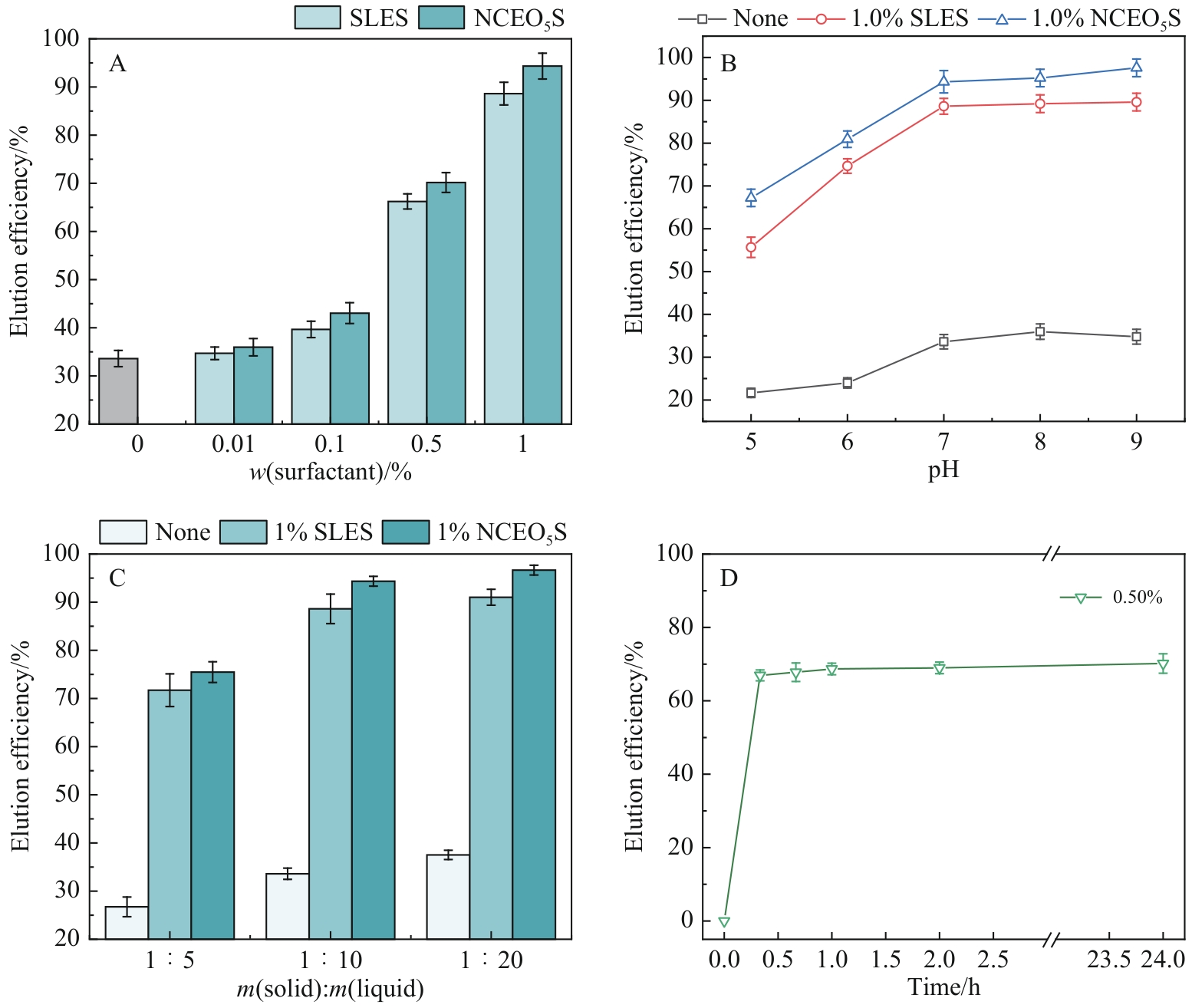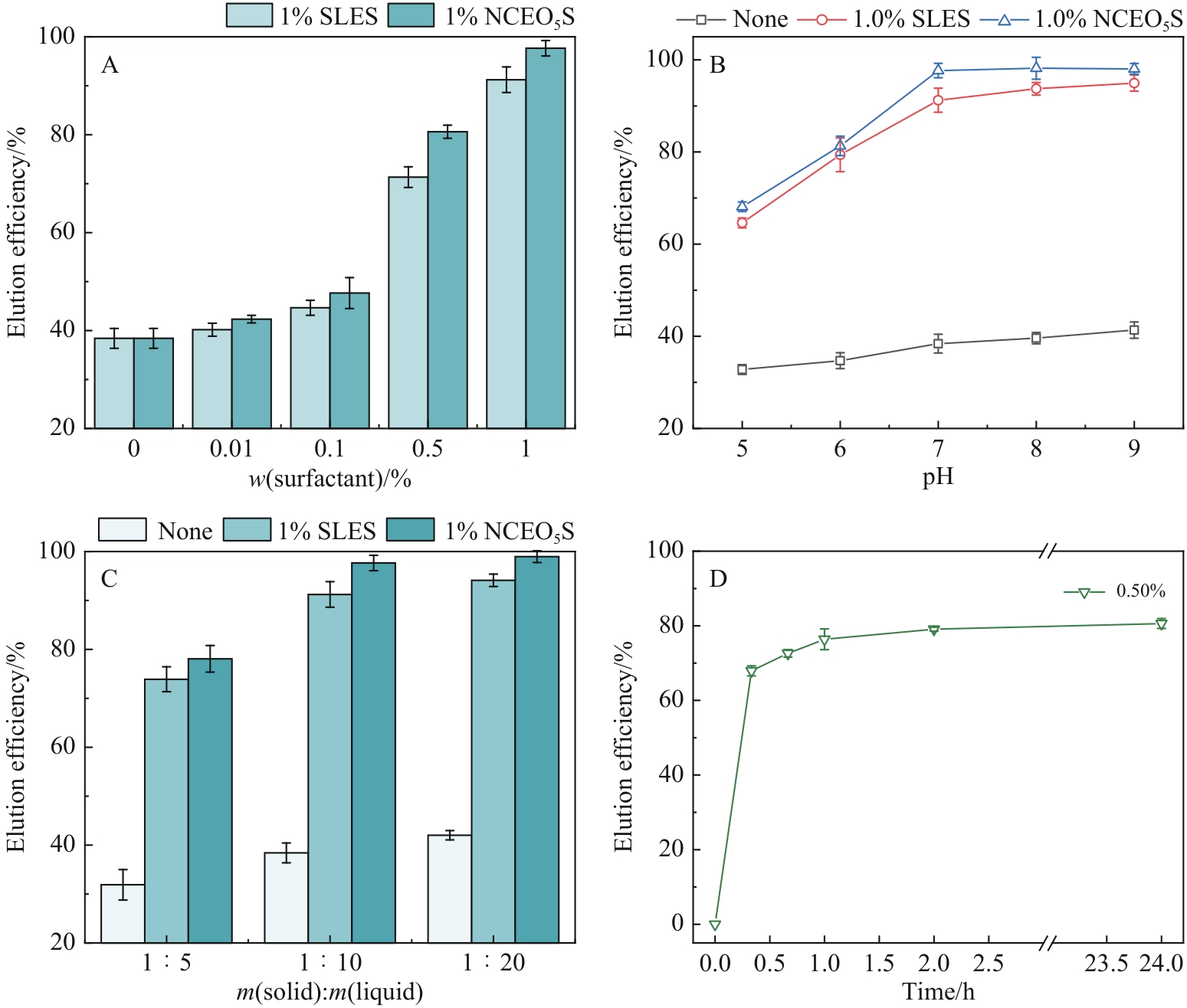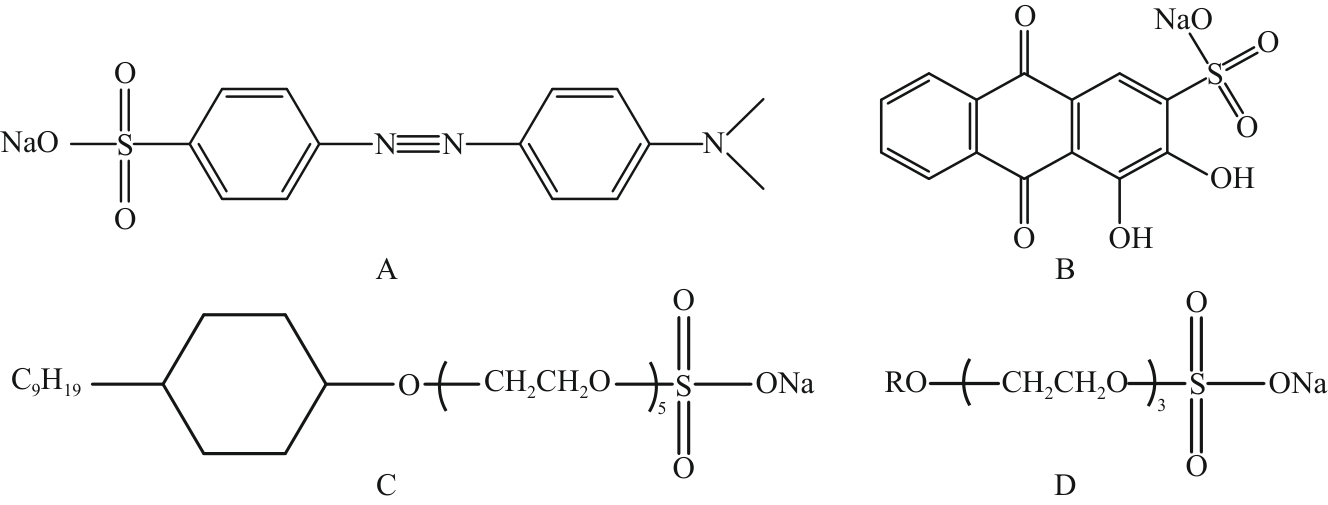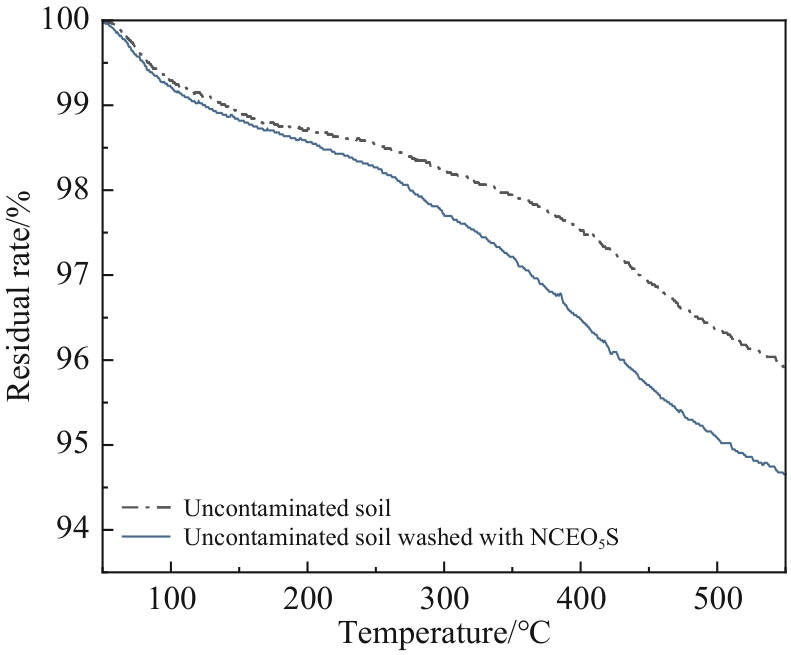
Chinese Journal of Applied Chemistry ›› 2025, Vol. 42 ›› Issue (2): 230-237.DOI: 10.19894/j.issn.1000-0518.240272
• Full Papers • Previous Articles Next Articles
Elution Effect of Sodium Polyether Sulfate Solution on Dyes from Dye-Contaminated Soil
Yong-Jin ZHANG1, Li-Wen SHI2, Huan-Jin ZOU2, Zhuo-Yu ZHOU1, Jian-Yi LIU1, Xue-Yi HU1( ), Yong-Mei XIA1
), Yong-Mei XIA1
- 1.School of Chemical and Material Engineering,Jiangnan University,Wuxi 214122,China
2.Zanyu Technology Group Co. ,Ltd. ,Hangzhou 310030,China
-
Received:2024-08-24Accepted:2024-12-22Published:2025-02-01Online:2025-03-14 -
Contact:Xue-Yi HU -
About author:xueyihu@jiangnan.edu.cn
-
Supported by:the Industry-University-Research Collaboration Project of Jiangsu Province(BY2021552);the Zanyu Research Fund (Open Collaborative Project) of Zanyu Technology Group Co., Ltd(24-KF-ZYJJ-03)
CLC Number:
Cite this article
Yong-Jin ZHANG, Li-Wen SHI, Huan-Jin ZOU, Zhuo-Yu ZHOU, Jian-Yi LIU, Xue-Yi HU, Yong-Mei XIA. Elution Effect of Sodium Polyether Sulfate Solution on Dyes from Dye-Contaminated Soil[J]. Chinese Journal of Applied Chemistry, 2025, 42(2): 230-237.
share this article
Add to citation manager EndNote|Ris|BibTeX
URL: http://yyhx.ciac.jl.cn/EN/10.19894/j.issn.1000-0518.240272

Fig.3 Theoretical and actual adsorption of dye-contaminated soil (A), comparison of methyl orange (B) and alizarin red (C) removed from blank solution and 1%SELS solution

Fig.4 Effect of surfactant mass fraction (A), pH (B), solid-liquid ratio (C), and elution time (D) on the elution rate of methyl orange from contaminated soil

Fig.5 Effect of surfactant mass fraction (A), pH (B), solid-liquid ratio (C), and elution time (D) on the elution rate of alizarin red from contaminated soil
| 1 | MON P P, CHO P P, CHANDANA L, et al. Biowaste-derived Ni/NiO decorated-2D biochar for adsorption of methyl orange[J]. J Environ Manage, 2023, 344: 118418. |
| 2 | BELKASSA K, KHELIFA M, BATONNEAU-GENER I, et al. Understanding of the mechanism of crystal violet adsorption on modified halloysite: hydrophobicity, performance, and interaction[J]. J Hazard Mater, 2021, 415: 125656. |
| 3 | SHANKAR V U, ALANAZI A K, SENTHIL KUMAR P, et al. An efficient electrochemical degradation of toxic pollutants in wastewater using BiOBr/BiVO4 hierarchical structured electrode material[J]. Chemosphere, 2023, 338: 139619. |
| 4 | OLUSEGUN S J, MOHALLEM N D S. Comparative adsorption mechanism of doxycycline and Congo red using synthesized kaolinite supported CoFe2O4 nanoparticles[J]. Environ Pollut, 2020, 260: 114019. |
| 5 | TANAYA K, KUMARI A, SINGH A K, et al. Bioremediation: an economical approach for treatment of textile dye effluent[J]. Water Air Soil Pollut, 2024, 235(8): 516. |
| 6 | KAUSHAL S, BANO K, KUMAR R. Metal-organic framework as an efficient photocatalyst[M]. Metal Organic Frameworks: Fundamentals to Advanced. Elsevier, 2024: 325-346. |
| 7 | WU Z, ZHU Z Q, MA J P, et al. High piezo-photocatalysis of BaTiO3 nanofibers for organic dye decomposition[J]. Surf Interfaces, 2024, 48: 104308. |
| 8 | SAMAL K, DAS C, MOHANTY K. Eco-friendly biosurfactant saponin for the solubilization of cationic and anionic dyes in aqueous system[J]. Dyes Pigm, 2017, 140: 100-108. |
| 9 | NGO T M V, TRUONG T H, NGUYEN T H L, et al. Surface modified laterite soil with an anionic surfactant for the removal of a cationic dye (crystal violet) from an aqueous solution[J]. Water Air Soil Pollut, 2020, 231(6): 285. |
| 10 | PHAM T D, PHAM T T, PHAN M N, et al. Adsorption characteristics of anionic surfactant onto laterite soil with differently charged surfaces and application for cationic dye removal[J]. J Mol Liq, 2020, 301: 112456. |
| 11 | KUMAR A, MOHAN D, PARAMKUSAM B R, et al. Efficacy of surfactants in the sustainable restoration of the geotechnical properties of diesel-contaminated soil[J]. Int J Environ Sci Technol, 2023, 21(1): 867-874. |
| 12 | RITORE E, COQUELET B, ARNAIZ C, et al. Guidelines for surfactant selection to treat petroleum hydrocarbon-contaminated soils[J]. Environ Sci Pollut R, 2022, 29(5): 7639-7651. |
| 13 | VAZQUEZ-VELEZ E, MONZON-MENDOZA J, MARTINEZ H, et al. Synthesis of non-ionic, cationic, and anionic surfactant from coconut oil for remediation of diesel contaminated soil[J]. Rev Mex Ing Quim, 2022, 21(3): IA2776. |
| 14 | ZHANG M, ZHU L. Effect of SDBS-Tween 80 mixed surfactants on the distribution of polycyclic aromatic hydrocarbons in soil-water system[J]. J Soil Sediment, 2010, 10(6): 1123-1130. |
| 15 | 黄昭露. 表面活性剂清洗柴油污染土壤的增效机制及二次污染阻控研究[D]. 上海: 东华大学, 2020. |
| HUANG Z L. Enhancement mechanisms of diesel contaminated soil washing/flushing with surfactants and additives and prevention of the secondary pollution[D]. Shanghai: Donghua University, 2020. | |
| 16 | 刘建益, 钱飞, 方银军, 等. 壬基环己醇聚氧乙烯醚硫酸钠的合成及性能 [J]. 精细化工, 2024, 41(1): 121-126, 221. |
| LIU J Y, QIAN F, FANG Y J, et al. Synthesis and properties of sodium nonylcyclohexanol ethoxylates sulfate[J]. Fine Chem, 2024, 41(1): 121-126, 221. | |
| 17 | CESCHIA E, HARJANI J R, LIANG C, et al. Switchable anionic surfactants for the remediation of oil-contaminated sand by soil washing[J]. RSC Adv, 2014, 4(9): 4638-4645. |
| 18 | OAKES J, GRATTON P. Solubilisation of dyes by surfactant micelles. part 1: molecular interactions of azo dyes with nonionic and anionic surfactants[J]. Color Technol, 2003, 119(2): 91-99. |
| 19 | TEHRANI-BAGHA A R, HOLMBERG K. Solubilization of hydrophobic dyes in surfactant solutions[J]. Materials, 2013, 6(2): 580-608. |
| 20 | VINAROV Z, KATEV V, RADEVA D, et al. Micellar solubilization of poorly water-soluble drugs: effect of surfactant and solubilizate molecular structure[J]. Drug Dev Ind Pharm, 2018, 44(4): 677-686. |
| 21 | 胡益涛. 壬基环己醇聚氧乙烯醚的合成与性能研究 [D]. 无锡: 江南大学, 2020. |
| HU Y T. Synthesis and properties of nonylcyclohexanol polyoxyethylene ether[D]. Wuxi: Jiangnan University, 2020. |
| [1] | Xiu-Ying PENG, Xiao-Yan GAO, Song-Bai WANG, Fu LIU. Catalytic Decolorization Performance of Azo Dyes by Doped Nano-Nickel with Three-Dimensional Network Porous Structure [J]. Chinese Journal of Applied Chemistry, 2024, 41(4): 557-567. |
| [2] | Xue-Bo LEI, Hui-Jing LIU, He-Yu DING, Guo-Dong SHEN, Run-Jun SUN. Research Progress on Photocatalysts for Degradation of Organic Pollutants in Printing and Dyeing Wastewater [J]. Chinese Journal of Applied Chemistry, 2023, 40(5): 681-696. |
| [3] | Yan-Long SHEN, Li-Ye CHENG, Xiang-Ru MENG, Qiong LI, Lian-Yun DU, En-Peng WANG, Chang-Bao CHEN. Effects of Ginseng Continuous Soil Crop on Growth Development and Antioxidant System of Ginseng at Different Fertility Stages [J]. Chinese Journal of Applied Chemistry, 2023, 40(1): 109-115. |
| [4] | Sheng-Jie LIU, Yong-Jie YE, Yin-Yi LIU, Shu-Man LIN, Hao-Yuan XIE, Wen-Ting LIU, Wei-Qin XU. Preparation of Uniformly Loaded Cu3P Nanoparticles in Porous Carbon Based on Copper Foam and Their Photocatalytic Performance for Dye Degradation [J]. Chinese Journal of Applied Chemistry, 2022, 39(7): 1090-1097. |
| [5] | Yi-Xin XU, Shuang WANG, Jing QUAN, Wan-Ting GAO, Tian-Qun SONG, Mei YANG. Preparation of Molybdenum Disulfide Quantum Dots/Reduced Graphene Oxide Composites and Their Photocatalytic Degradation of Organic Dyes, Tetracyclines and Cr(VI) [J]. Chinese Journal of Applied Chemistry, 2022, 39(5): 769-778. |
| [6] | Jing-Wan LIU, Qiong LI, Tao ZHANG, En-Peng WANG, Huan WANG, Xue CHEN, Chang-Bao CHEN. Research Progress on the Continuous Cropping Obstacles of Ginseng from Soil Improvement [J]. Chinese Journal of Applied Chemistry, 2022, 39(12): 1818-1832. |
| [7] | WU Yu, LIU Jia-Cheng. Preparation and Characterization of Dye-sensitized Solar Cells by Inverted Coordination Self-assembly [J]. Chinese Journal of Applied Chemistry, 2021, 38(11): 1494-1502. |
| [8] | LIN Yongcen, DONG Xue, MA Yuqin, ZHAO Lang. Designed Formation of NiCo-Layered Double Hydroxide Derived from Zeolitic Imidazolate Framework-67 with Selective Dye Adsorption Property [J]. Chinese Journal of Applied Chemistry, 2020, 37(6): 683-694. |
| [9] | ZHOU Yao, LUO Ziqing, ZHOU Jialing, YUAN Lin, LI Zhongyan. Dipeptide-Based Phase-Selective Gelators for Removal of Oils and Toxic Dyes from Water [J]. Chinese Journal of Applied Chemistry, 2020, 37(11): 1276-1284. |
| [10] | SHENG Lei,LI Tingyu,GUO Lifang,LI Gang,ZHANG Wendong. Application of Functionalized Multi-walled Carbon Nanotubes Filled Gel Electrolyte in Dye-Sensitized Solar Cells [J]. Chinese Journal of Applied Chemistry, 2019, 36(7): 815-822. |
| [11] | WANG Xingyue, ZHANG Shiyue, QU Weidong, GONG Weitao, NING Guiling. Synthesis of Pillar[5]arene-Based Porous Organic Polymers and Their Adsorption Properties [J]. Chinese Journal of Applied Chemistry, 2019, 36(10): 1147-1154. |
| [12] | YANG Mei,SHI Zhenling,XU Nan,MAO Dan,WANG Dan. Research Progress of Hollow Micro/Nano-Structured Photoanode Materials for Dye-Sensitized Solar Cells [J]. Chinese Journal of Applied Chemistry, 2018, 35(8): 902-915. |
| [13] | WANG Yue,CAI Chen,LIU Huiling,SUN Li,LI Yanchao,MENG Zhaohong. Quantitative Analysis of Cephalosporin C in Soil by High Performance Liquid Chromatography with Ultrasound-assisted Extraction and Solid-Phase Extraction [J]. Chinese Journal of Applied Chemistry, 2018, 35(6): 722-728. |
| [14] | FU Chang'e, CHEN Wan, DAI Zhaoxia, XIANG Qizhi. Adsorption of Two Anionic Organic Dyes Methyl Orange and Alizarin Green Using a Magnetic Covalent Organic Frameworks [J]. Chinese Journal of Applied Chemistry, 2018, 35(5): 594-599. |
| [15] | SUN Qi, WANG Liqiu, LIU Yang, GUO Chenxiao, WANG Pengjun, LIU Xuelong, ZHANG Xiaobo, ZHENG Lihui, LIU Liping. Preparation and Properties of Near Infrared Polyvinyl Alcohol Fluorescent Polymer Materials [J]. Chinese Journal of Applied Chemistry, 2018, 35(1): 53-59. |
| Viewed | ||||||
|
Full text |
|
|||||
|
Abstract |
|
|||||


